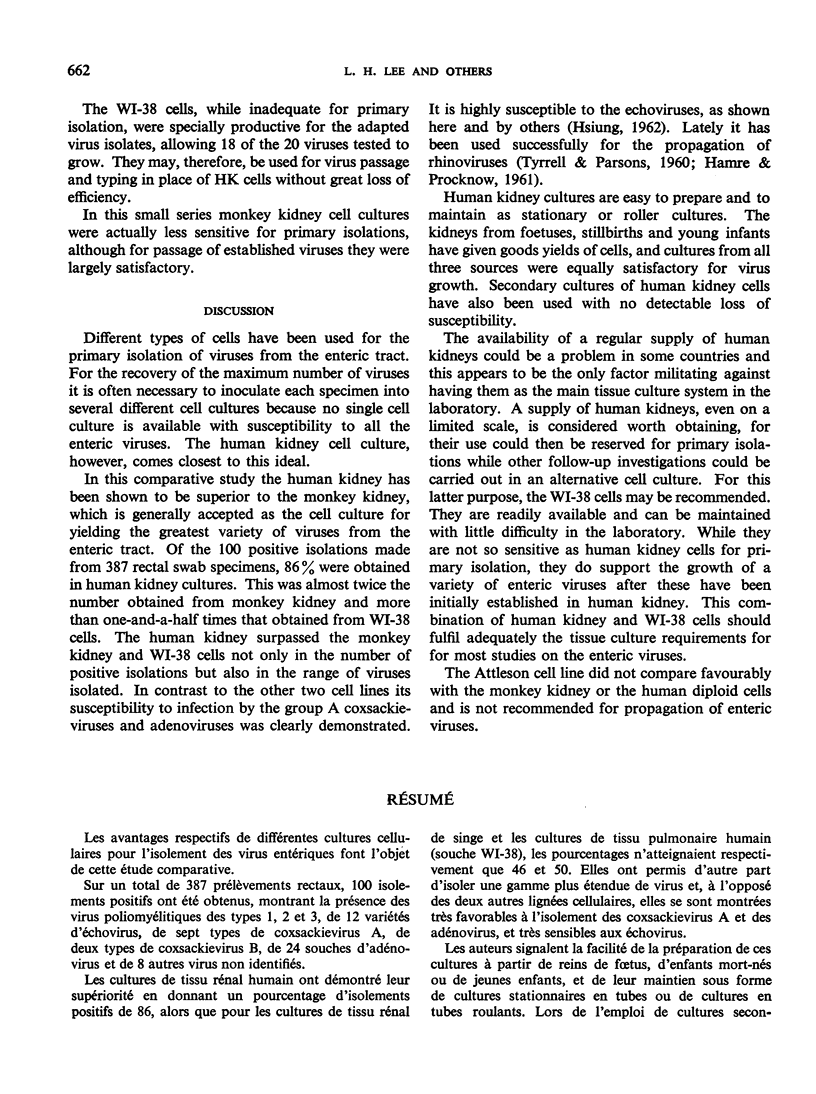Abstract
The need for establishing an optimum tissue culture cell line for isolation of enteric viruses prompted a comparative study of cell lines for the isolation of enteric viruses from rectal swab specimens. The viruses isolated included all three types of poliovirus, 12 types of echovirus, seven types of group A and two of group B coxsackievirus, 24 strains of adenovirus, and eight untyped agents which probably represent new enteroviruses. One hundred positive isolations were made from 387 rectal swab specimens; 86 were obtained in human kidney cultures. This was almost twice the number obtained with monkey kidney and more than one-and-a-half times that obtained with human lung cells (WI-38). A diploid human epithelial cell line (Attleson) was tested and was found to be inferior to both monkey kidney and WI-38 cells for enteric viruses. Human kidney cells were particularly useful for group A coxsackieviruses and adenoviruses.
Full text
PDF






Selected References
These references are in PubMed. This may not be the complete list of references from this article.
- HAMRE D., PROCKNOW J. J. Virological studies on acute respiratory disease in young adults. I. Isolation of ECHO 28. Proc Soc Exp Biol Med. 1961 Aug-Sep;107:770–773. doi: 10.3181/00379727-107-26749. [DOI] [PubMed] [Google Scholar]
- HSIUNG G. D. Further studies on characterization and grouping of ECHO viruses. Ann N Y Acad Sci. 1962 Nov 30;101:413–422. doi: 10.1111/j.1749-6632.1962.tb18880.x. [DOI] [PubMed] [Google Scholar]
- HSIUNG G. D., MELNICK J. L. Comparative susceptibility of kidney cells from different monkey species to enteric viruses (poliomyelitis, Coxsackie, and echo groups). J Immunol. 1957 Feb;78(2):137–146. [PubMed] [Google Scholar]
- HSIUNG G. D., MELNICK J. L. Orphan viruses of man and animals. Ann N Y Acad Sci. 1958 Jun 3;70(3):342–361. doi: 10.1111/j.1749-6632.1958.tb35393.x. [DOI] [PubMed] [Google Scholar]
- KALTER S. S., FUENTES-MARINS R., RODRIGUEZ A. R., HELLMAN A., CRANDELL R. A., WERTHESSEN N. T. Susceptibility of baboon (Papio doguera) kidney cells to human enteroviruses. Proc Soc Exp Biol Med. 1962 Nov;111:337–340. doi: 10.3181/00379727-111-27784. [DOI] [PubMed] [Google Scholar]
- KELLY S., SANDERSON W. W. Comparison of various tissue cultures for the isolation enteroviruses. Am J Public Health Nations Health. 1962 Mar;52:455–459. doi: 10.2105/ajph.52.3.455. [DOI] [PMC free article] [PubMed] [Google Scholar]
- LIM K. A., BENYESH-MELNICK M. Typing of viruses by combinations of antiserum pools. Application to typing of enteroviruses (Coxsackie and ECHO). J Immunol. 1960 Mar;84:309–317. [PubMed] [Google Scholar]
- MARCHETTI G. E., GELFAND H. M. USE OF HEP-2 CELLS FOR GROUPING ENTEROVIRUSES. Public Health Rep. 1963 Sep;78:813–817. [PMC free article] [PubMed] [Google Scholar]
- SCHMIDT N. J., GUENTHER R. W., LENNETTE E. H. Typing of ECHO virus isolates by immune serum pools. The "intersecting serum scheme". J Immunol. 1961 Nov;87:623–626. [PubMed] [Google Scholar]
- TYRRELL D. A., PARSONS R. Some virus isolations from common colds. III. Cytopathic effects in tissue cultures. Lancet. 1960 Jan 30;1(7118):239–242. doi: 10.1016/s0140-6736(60)90168-9. [DOI] [PubMed] [Google Scholar]
- WALLIS C., MELNICK J. L. Suppression of adventitious agents in monkey kidney cultures. Tex Rep Biol Med. 1962;20:465–475. [PubMed] [Google Scholar]
- WENNER H. A. Problems in working with enteroviruses. Ann N Y Acad Sci. 1962 Nov 30;101:343–356. doi: 10.1111/j.1749-6632.1962.tb18876.x. [DOI] [PubMed] [Google Scholar]


